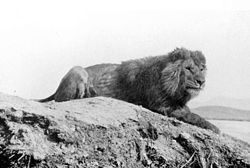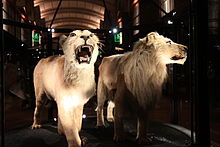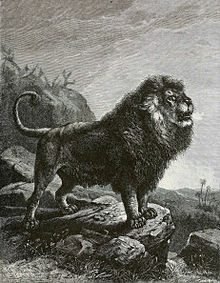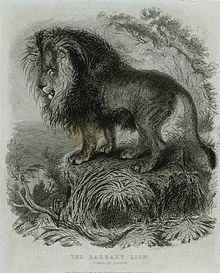- Barbary lion
-
Barbary lion 
A Barbary lion from Algeria, photographed by Sir Alfred Edward Pease around 1893 Conservation status Scientific classification Kingdom: Animalia Phylum: Chordata Class: Mammalia Order: Carnivora Family: Felidae Genus: Panthera Species: P. leo Subspecies: P. l. leo Trinomial name Panthera leo leo
(Linnaeus, 1758)Synonyms Felis leo Linnaeus, 1758
Panthera leo berberiscaThe Barbary lion (Panthera leo leo), also known as the Atlas lion or Nubian lion, is a subspecies of lion that became extinct in the wild or extinct in the 20th century.
The Barbary lion formerly ranged in North Africa from Morocco to Egypt. The last known Barbary lion in the wild was shot in the Atlas Mountains in 1922.[1] The Barbary lion was believed to be extinct in captivity as well. However, possible Barbary lion individuals or descendants have been located in zoos and circus populations within the last three decades.[citation needed]
The Barbary lion is often regarded as the largest and the heaviest of the lion subspecies with estimated weights for the males of 180 to 270 kilograms (400 to 600 lb) and for females of 120 to 180 kilograms (260 to 400 lb).[2] These weight ranges have been criticized for being greatly exaggerated, however, with the Barbary lion being considered to be similar in size to the lions in East Africa.[3]
The two other primary predators of northern Africa, the Atlas bear and Barbary leopard, are now also extinct, and close to extinction, respectively.
Contents
Barbary lions in captivity and possible surviving individuals
The Romans used Barbary lions in the Coliseum to battle with Gladiators.[3] In the Middle Ages, the lions kept in the menagerie at the Tower of London were Barbary lions, as shown by DNA testing on the two well-preserved skulls excavated at the Tower in 1937.[4] The skulls have been radiocarbon dated to 1280-1385 AD and 1420-1480 AD. Dr Nobuyuki Yamaguchi of the Wildlife Conservation Unit at the University of Oxford said the growth of civilizations along the Nile and in Sinai Peninsula by the beginning of the second millennium BC stopped genetic flow, thereby isolating lion populations. The lion survived in the wild in northwestern Africa in what is now current day Libya, Tunisia, Algeria and Morocco until about 100 years ago.[when?][4]
In the 19th century and the early 20th century Barbary lions were often kept in hotels and circus menageries. The lions in the Tower of London were transferred to more humane conditions at the London Zoo in 1835, on the orders of the Duke of Wellington. One famous purebred Barbary lion named "Sultan" lived in the London Zoo in 1896[5].
 Possible Barbary lion in captivity Ljubljana Zoo
Possible Barbary lion in captivity Ljubljana Zoo
There is also a male Barbary lion named Beemer at the Wisconsin Big Cat rescue in Rock Springs. Another one is known from Leipzig. Currently several dozen individuals in captivity are believed to be Barbary lions: Port Lympne Wild Animal Park has twelve specimens [6] descended from animals owned by the King of Morocco. In addition, eleven animals believed to be Barbary lions were found in Addis Ababa zoo, descendants of animals owned by Emperor Haile Selassie. In addition, Zion Wildlife Gardens in New Zealand has several Barbary lions.[citation needed] It is thought that approximately 250 individuals are left in the world. There are supposed Barbary lions in South Africa in captivity and is part of this species conservation and are supposed to be found in some circuses around the world.[citation needed] Also, in 2006, a female lion named Sarabi lived at Big Cat Rescue, a wild cat santuary in Tampa, Florida. Sadly, Sarabi passed away before helping with the Barbary Lion population. Another lioness at Big Cat Rescue, Nickita, is believed to have traits of the Barbary Lion, in that she is the size of Sarabi and is almost double the size of the male lions at the sanctuary, Joseph and Cameron.[citation needed]
In the past scientists believed that the distinct subspecies status of the Barbary lion was established by its seemingly fixed external morphology, particularly its heavier mane. However, it is now known that various extrinsic factors influence the color and size of all lions' manes, such as ambient temperature.[7] As the cooler ambient temperature in European and North American zoos has been found to produce Barbary-like manes on ordinary lions, this characteristic is now considered an inappropriate marker for identifying Barbary ancestry.[8][9]
Despite this, mitochondrial DNA research published in 2006 does support the distinctness of the Barbary lions as a subspecies. The results found a unique mtDNA haplotype to be present in some of those museum specimens believed to be of Barbary descent. This may be a good molecular marker for identifying—and excluding—other potential Barbary lions.[9] The mtDNA results revealed that five tested samples of lions from the famous collection of the King of Morocco are not, according to this criterion, maternally Barbary.[9] However, in the same year, mtDNA research revealed that a lion specimen from Neuwied Zoo (which originated from the collection of the King of Morocco) is not of sub-Saharan origin according to its mitochondrial lineage and, thus, very likely a descendant of a Barbary lion.[10]
In 2008, in a major study published in PLOS Genetics, it was found that four "Atlas" lions from Morocco did not exhibit any unique genetic characteristics.[11] However, the Moroccan cats shared mitochondrial haplotypes (H5 and H6) with central African lions, and together with them were part of a major mtDNA grouping (lineage III) that also included Asiatic samples. According to the authors, this scenario was in line with their theories on lion evolution. They conclude that lineage III developed in east Africa, and then travelled north and west in the first wave of lion expansions out of the region some 118,000 years ago. It apparently broke up into haplotypes H5 and H6 within Africa, and then into H7 and H8 in west Asia.
While the historical Barbary lion was morphologically distinct, its genetic uniqueness remains questionable, and the taxonomic status of surviving lions frequently considered as Barbary lions, including those that originated from the collection of the King of Morocco, is still unclear.[12]
The Barbary Lion Project
The former popularity of the Barbary Lion as a zoo animal provides the only hope to ever see it again in the wild in North Africa. Many zoos provide mating programmes, which will help to increase the population of the species.
After years of research into the science of the Barbary Lion and stories of surviving examples, WildLink International, in collaboration with Oxford University, launched their ambitious International Barbary Lion Project. They are using the very latest DNA techniques to identify the DNA 'fingerprint' of the Barbary Lion subspecies. WildLink International has taken bone samples from remains of Barbary Lions in museums across Europe, like those in Brussels, Paris, Turin and others. These samples are returned to Oxford University where the science team is extracting the DNA sequence that identifies the Barbary as a separate subspecies.
Although the Barbary may be extinct, and is certainly extinct in the wild, WildLink International identified a handful of lions in captivity around the world that may be descended from the original Barbary Lion, like the royal lions in Temara Zoo in Rabat, Morocco. These descendants will be tested against the DNA fingerprint and the degree of any hybridization (from crossbreeding) can then be determined. The best candidates will then enter a selective breeding program that will 'breed back' the Barbary Lion. The final phase of the project will see the lions released into a National Park in the Atlas Mountains of Morocco.
As of March 2010, two cubs have been moved to 'The Texas Zoo' in Victoria, Texas where efforts are being made to preserve the endangered species under the WildLink International conservation program. The two cubs are offspring of the Barbary lion couple Cleopatra and Caesar, residents at the Austin zoo in Texas. The cubs used to be named Anastasia and Memphis but were renamed Gaia and Aesa upon being moved to their current location in Victoria. [13]
Asiatic Lion—an Asian relative
In 1968, a study[clarification needed] on the skulls of the Barbary, extinct Cape, Asiatic, and other African lions showed that the same skull characteristics—the very narrow postorbital bar—existed in only the Barbary and the Asiatic lion skulls. This shows that there may have been a close relationship between the lions from Northernmost Africa and Asia. It is also believed[by whom?] that the South European Lion that became extinct in 80-100 AD, could have represented the connecting link between the North African and Asiatic lions. It is believed that Barbary lions possess the same belly fold (hidden under the mane) that appears in the Asian lions today.
See also
References
- ^ Nowell K, Jackson P, ed (1996). "Panthera Leo" (PDF). Wild Cats: Status Survey and Conservation Action Plan. Gland, Switzerland: IUCN/SSC Cat Specialist Group. pp. 17–21. ISBN 2-8317-0045-0. http://carnivoractionplans1.free.fr/wildcats.pdf.
- ^ http://dinosaurs.about.com/od/mesozoicmammals/p/Barbary-Lion.htm
- ^ a b Patterson, Bruce D. (2004). The lions of Tsavo: exploring the legacy of Africa's notorious man-eaters. McGraw-Hill Professional. p. 110. ISBN 9780071363334.
- ^ a b "Tower's royal lions 'from Africa'". BBC News. BBC. 2008-03-25. http://news.bbc.co.uk/2/hi/science/nature/7311134.stm. Retrieved 2009-07-26.
- ^ Edwards, John. 1996. London Zoo from Old Photographs 1852–1914
- ^ [1][dead link]
- ^ West PM, Packer C (August 2002). "Sexual selection, temperature, and the lion's mane". Science 297 (5585): 1339–43. doi:10.1126/science.1073257. PMID 12193785.
- ^ Yamaguchi, N. & Haddane, B. (2002). The North African Barbary lion and the Atlas Lion Project. International Zoo News 49: 465-481.
- ^ a b c Barnett, Ross (2006). "Lost populations and preserving genetic diversity in the lion Panthera leo: Implications for its ex situ conservation". Conservation Genetics 7: 507. doi:10.1007/s10592-005-9062-0. http://abc.zoo.ox.ac.uk/Papers/consgen06_lion.pdf.
- ^ Burger, Joachim (2006). "Urgent call for further breeding of the relic zoo population of the critically endangered Barbary lion (Panthera leo leo Linnaeus 1758)". European Journal of Wildlife Research 52: 54. doi:10.1007/s10344-005-0009-z. http://www.uni-mainz.de/FB/Biologie/Anthropologie/MolA/Download/Burger%20Hemmer%202006.pdf.
- ^ Antunes A, Troyer JL, Roelke ME, et al. (November 2008). "The evolutionary dynamics of the lion Panthera leo revealed by host and viral population genomics". PLoS Genet. 4 (11): e1000251. doi:10.1371/journal.pgen.1000251. PMC 2572142. PMID 18989457. http://www.pubmedcentral.nih.gov/articlerender.fcgi?tool=pmcentrez&artid=2572142.
- ^ Black, S., Yamaguchi, N., Harland, A. & Groombridge, J. (2010). "Maintaining the genetic health of putative Barbary lions in captivity: an analysis of Moroccan Royal Lions". Eur. J. Wildl. Res. 56: 21–31. doi:10.1007/s10344-009-0280-5.
- ^ http://www.austinzoo.org/zoostall/wp-content/uploads/2010/03/AZOO_Cubs-Relocation.pdf
Categories:- IUCN Red List extinct in the wild species
- Lions
- Megafauna of Africa
- Carnivorans of Africa
- Extinct animals of Africa
- Species made extinct by human activities
- Mammal extinctions since 1500
- Fauna of Morocco
- Fauna of Algeria
Wikimedia Foundation. 2010.




